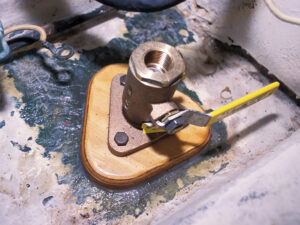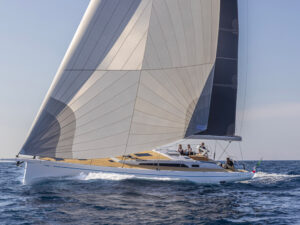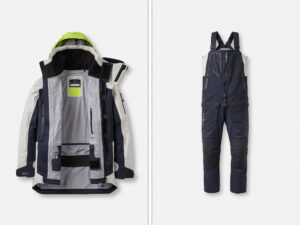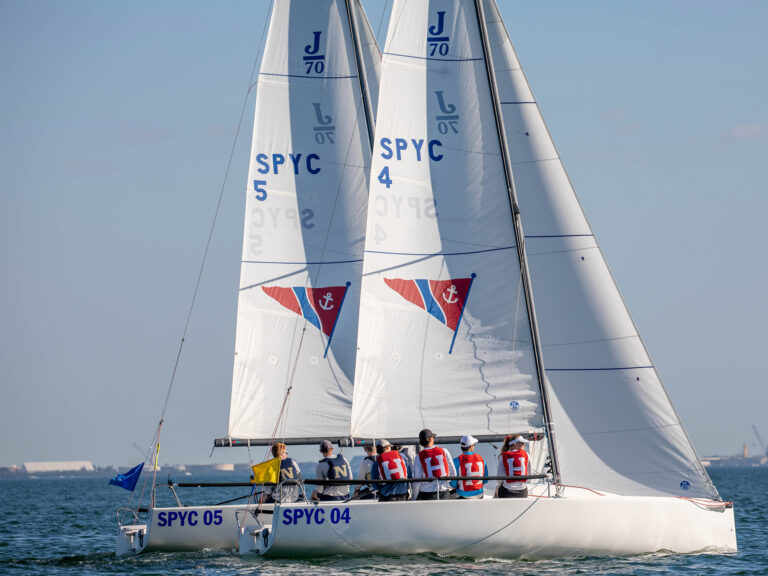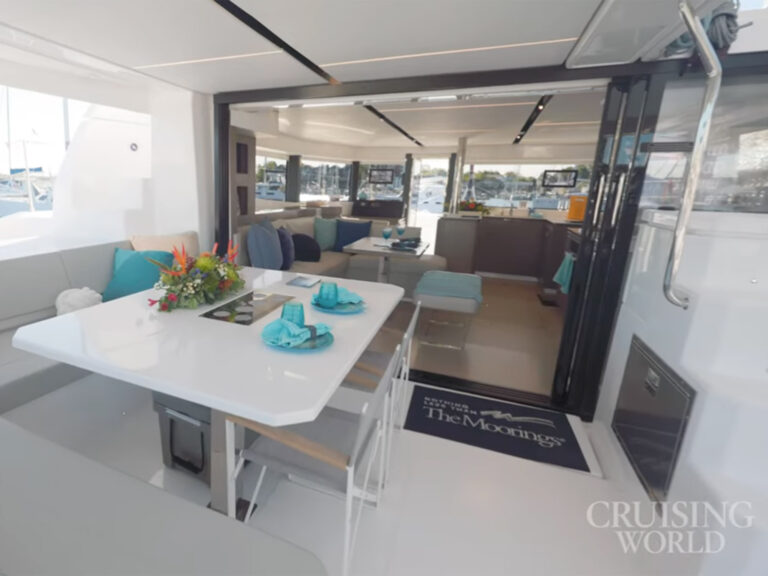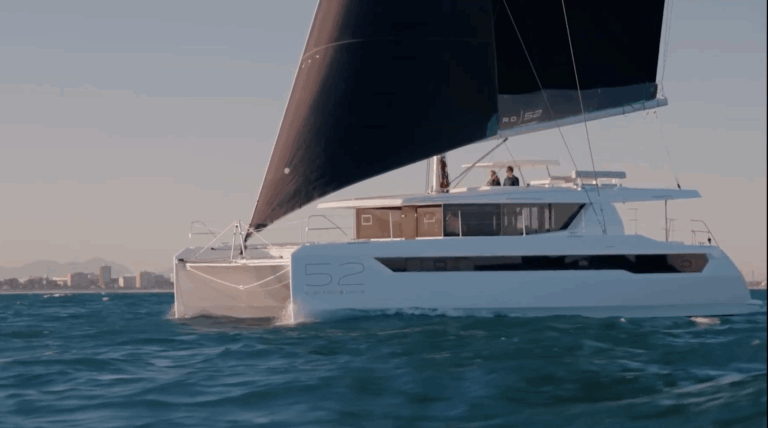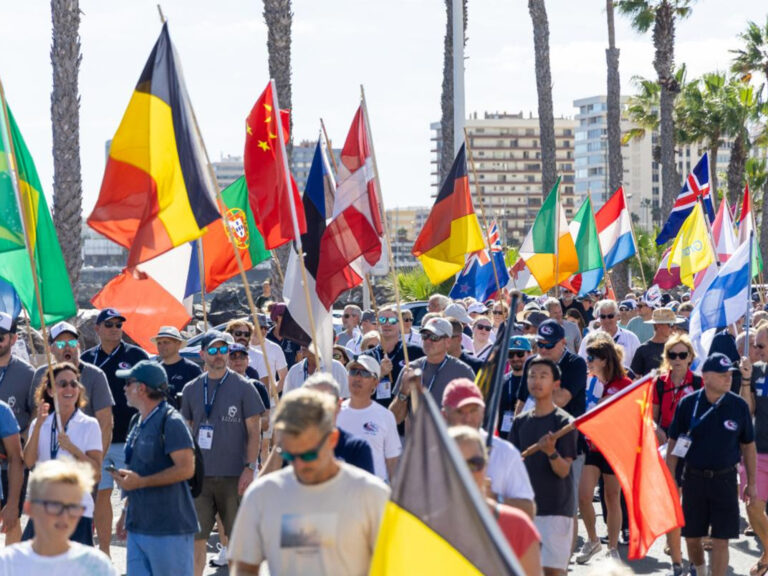If you’re hunting for a cruising sailboat that won’t limit your horizons, you’d do well to drop in on Orust. The largest island on the western coast of Sweden, Orust covers a mere 45 square miles and has only about 16,000 residents. Yet the island produces more than 50 percent of Sweden’s sailboat exports; roughly half of the island’s tradesmen build sailboats. In other words, sailboats are serious business on Orust.
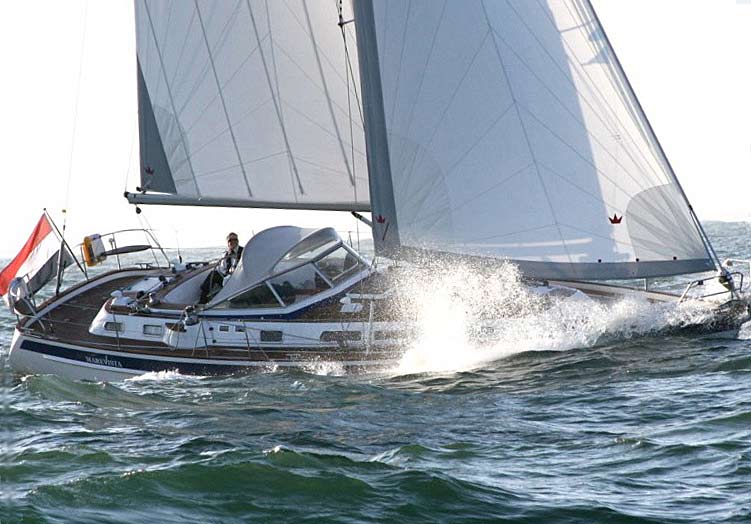
Among the latest crop of boats coming from Orust were three new models that I sailed last fall on Chesapeake Bay: the Hallberg-Rassy 43, the Malö 41, and the Najad 460, all products of yards just a short distance apart from each other. Stoutly built and well appointed, they share many similar elements—ample freeboard, glass windscreens, superior joinery, and teak decks are among the most obvious parallels. Yet each maker has successfully found its own subtle niche.
While each of the three had its own strengths, for the whole package the HR 43 was named CW’s 2003 Overall Boat of the Year.
Hallberg-Rassy Hits New Level
Anytime Hallberg-Rassy introduces a new model in the 40-foot range, it’s certain to draw interest from the serious cruiser. One of the boat’s strongest points is its deck layout and its all-around ease of use, reflecting a good notion of what works and what doesn’t. From the anchor windlass to the teak-covered boarding steps, the boat is assembled with user-friendliness in mind. With teak handholds inboard along the cabin top and rugged stanchions and bulwarks outboard, the boat makes movement on deck as surefooted as it is in the relatively deep well of the cockpit. Pulpits at the mast make halyard duty safe and simple.
Handling was notably straightforward on the boat I sailed because of the in-mast roller furling. The performance with a furling main—which reduces overall sail area in comparison with a full-batten mainsail or with the standard partial-batten mainsail—was surprisingly sharp.
Our judges gave much of the credit for the improved performance of this boat, in comparison with Hallberg-Rassys of a generation ago, to the designer Germán Frers, who since 1988 has been applying to Hallberg-Rassy’s cruising line knowledge gained from his experience designing boats for the America’s Cup and the Whitbread/Volvo Ocean race. “She was a very solid vessel,” said CW technical editor and Boat of the Year judge Ralph Naranjo. “There was no flex, no groan, no distortion to the hull. This is essential for a deck-stepped spar, which she had. It’s a beefy discontinuous rig.”
John Albertine of Freestate Yacht Brokerage and I hopped aboard the HR 43 in Edgewater, Maryland, just as the dark sky opened up. With a cambered hard dodger that joined the windscreen, her cockpit provides a cozy refuge when weather sets in.
Bound for Annapolis, we powered around Thomas Point Light with the new D2-55 55-horsepower Volvo quietly ushering us into 12 knots of wind at 7.0 knots at 2,400 rpm. Based on a Perkins block, this is a high-torque engine that runs at lower rpm than the Yanmars. With the autopilot engaged, we dipped beneath the hard dodger and watched the rain bead up on the windscreen.
Once round the point, the main went up, and we motorsailed through square chop at 7 knots with very little pounding. Even below in the V-berth, the ride was agreeable. Additional bulkheads beneath the bunk and forward provide reinforcement here, and an elegantly curved wooden partition between the berths adds eye appeal.
A few miles south of the Severn River, we unfurled the working jib and started tacking against the wind and tide in gusty breezes of 12 to 15 knots. Like the Najad, the Hallberg-Rassy’s mainsheet traveler runs aft of the cockpit. The setup puts the helmsman right at the mainsheet and within reach of the jib sheet. The boat didn’t hurtle through the tacks; she accelerated well in the gusts and tracked nicely.
She easily held 7 knots and tacked through 90 degrees, and in some of the stronger gusts an insistent weather helm beckoned a reef. But rather than taking in sail, we bore off on a reach and enjoyed the ride. The boat quickly flattened out and picked up steam, with the knot log hovering at just under 8 knots—delightful for a boat that favors seakeeping ability over speed and doesn’t skimp on comforts belowdecks. A fold-down step at the helm seat allowed me to peek over the top of the hard dodger, which is right at eye level for people of average height.
The double-cabin arrangement offers fine accommodations no matter which end of the boat you bunk in. One disappointment was that some of the cushions were only covered on three sides, with the material stapled to plywood backs. Each cabin has its own head and separate shower and ample storage space. Hatches and cowls over both cabins allow plenty of air below, and the main-cabin layout, featuring a drop-leaf table, allows quick passage fore and aft—no steps to negotiate or furniture to squeeze past.
Benefiting from long experience in building world cruisers—Hallberg-Rassy sold hull number 8,000 last year—this yard has a firm grasp of ideal installations and systems for cruising. Ralph praised the Whitlock steering and the self-launching ground-tackle system. Of the latter he said, “This was one of the few that when you push the button for the anchor to go down, it goes down automatically. You didn’t have to push the anchor off the roller.”
The construction details show similar consideration. The hull is built in two halves that are joined along the centerline, and overlapping laminate joins the hull and deck. A rugged integral rubbing strake runs the length of the hull. The hull is solid laminate below the waterline, with sandwich-construction Divinycell PVC foam above the waterline.
The judges found few minuses on the HR 43. Sailmaker and BOTY judge Carol Hasse recommended line guards for the dorade vents. Ralph felt that the primary winches were located too close to the dodger to allow adequate clearance. The battery compartment’s vent was located low in the stern, exposed to a breaking sea; Skip Moyer, a CW BOTY judge and past president of the American Boat & Yacht Council, suggested moving it to a less vulnerable location. One item needed immediate attention: In reverse, the combination throttle and shift lever blocked the spokes of the wheel, interfering with steering when in reverse. Lastly, the mast step should be pinned at the step, in accordance with ORC regulations and good seamanship.

A Stunning Interior
Of the three boats, the Malö 41 is immediately distinguishable by its aft cockpit and Targa-style arch, which accommodates the mainsheet traveler. The arch preserves the advantages of an end-of-boom sheeting arrangement with few compromises. Although the 19-inch-long track for the mainsheet traveler is relatively short, it doesn’t impinge on cockpit space, and a rigid Seldén vang allows for fine trim on all points of sail. The mainsheet leads to a winch that’s mounted within reach of the helmsman.
The arch also provides a convenient support for a soft or hard dodger, a bimini top, or a full canvas cockpit enclosure for inclement climes. The curved glass of the Malö 41 sets it apart from its peers, as does the oversized, 30-millimeter stainless-steel tubing for stanchions and pulpits. It’s the only boat of the three that offers a shoal-draft option.
“In terms of beauty and function and storage and ease of maintenance, this was among the best of any of the boats we saw this year,” said Carol.
All three boats feature teak decks fastened over cored decks, something the BOTY judges didn’t like, but the builders go to great extremes to protect against water penetration. Most of the Malö’s deck hardware is bolted through fiberglass riser pads, not teak, leaving no path for moisture to reach the core. Where these risers occur, solid laminate replaces core; in some places, the hardware is bolted into aluminum flat stock encapsulated in the deck, eliminating through-deck penetrations. Owners have a choice of balsa or Divinycell core in the deck as well as the hull.
The hull is hand-laid solid glass below the boot stripe and balsa-core sandwich construction above. A molded rubstrake with an aluminum cap protects the hull. Three watertight compartments forward provide reassurance in the event of a collision. The main bulkhead, which acts as a ring frame, handles compression loads from the deck-stepped mast. Chainplates are bolted into long, solid-glass knees tabbed to the hull. Rig details include a split backstay (opening up access to the transom swim platform) and a removable inner forestay for a staysail or storm jib.
Malö, in business since 1939, builds fewer than 40 boats each year, and the yard encourages owner input, particularly regarding interior details. This flexibility is even more impressive when one considers that the hull/deck joint is bedded in 3M 5200, through-bolted, then glassed over. This bulletproof hull/deck joint requires that all machinery, equipment, furnishings, and independent tanks enter through the main companionway—a boon to the owner when the time comes to replace or service these items.
The options extend to the profile, as Malö offers two different transom shapes and two versions of each. The “classic” counter stern offers the advantage of added storage in the fantail lockers and an optional fold-down dive platform and swim ladder. Evoking a sleeker look, the reverse-counter version is available with or without an integral bathing platform and access steps.
The full hull sections never really turn flat, so the boat feels big for a 41-footer, both on deck and below. Malö offers four different interior arrangements, although these also can be modified to taste. The boat I sailed featured an L-shaped galley to port that was rich with nifty features, a convenient head and nav station to starboard, a well-lit saloon, a roomy V-berth and adjoining head forward, and a comfortable double cabin aft to port. A cruising sailor looking for an extra sea berth might choose the settee to starboard in lieu of the two armchairs featured on the version I sailed. Comparing the superior joinery work to that of a finely crafted piano, the BOTY judges regarded the Malö’s satin-finished mahogany interior as the finest of the three boats.
The boat’s onboard systems earned similar praise. “From an engineering perspective, engine access and installation were superb,” said Skip . “The raw-water strainer was under the sole by the galley, where you could get to it easily. The fuel filter was right under the companionway steps.”
A notable engine-installation detail on the Malö is the Aqua Drive, also used on the Najad and the Hallberg-Rassy. The flexible drive connection isolates the engine from the prop shaft, canceling alignment problems and allowing the engine to be installed on softer mounts, reducing vibration. With the 75-horsepower turbocharged Yanmar purring at 2,500 rpm, about 70 percent of its rated rpm, the Malö powered at 7.2 knots in smooth water. In reverse, the Flex-O-Fold propeller quickly stopped the boat; goosing the throttle in forward brought the boat quickly to her feet again. The optional bow thruster enabled the boat to shoehorn out of a tight slip that would require many boats her size to rely on warps.
In 8 to 10 knots of wind on Chesapeake Bay, I sailed the classic-deck version with a conventional full-batten main and a 140-percent roller-furling genoa. The Whitlock rod-linkage steering system, combined with a responsive underbody, gave an impression of nimbleness that was surprising for a boat that felt so solid underfoot. We tacked well through about 90 degrees; when cracked off the wind, the boat held about 6.8 knots with a desirable touch of weather helm.
The Malö had only a few items I’d wish to see changed. The boat I sailed had an anchor bow roller through the stem; although it made for a clean foredeck, for security in a dicey anchorage I’d prefer the optional deck-mounted twin roller. Carol recommended upgrading to a different release system for the removable inner forestay, one that didn’t leave such a prominent toe-stubber on deck and allowed the stay to be tensioned when a sail was set. In the cockpit, the proximity of the secondary winches to the primaries made it hard to operate both at the same time.
The Malö 41 is by the strictest measure a bluewater voyager that will go anywhere in comfort—no matter how cold or ugly the day. As sailed, the boat lists at $375,000.
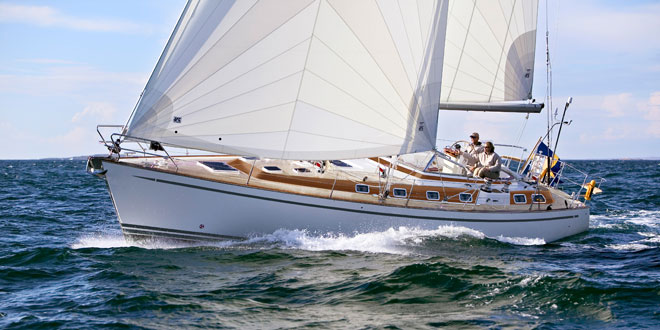
A Najad for All Seasons
Stepping up from the smaller Malö to the 46-foot Najad 460 offers a lesson in the difference a few extra feet can make. This center-cockpit sloop makes good use of the additional interior volume as well as the long waterline that guarantees faster passages.
The potential of this Najad (pronounced NIGH-add) for devouring miles became obvious once we cleared Spider Light, outside the Severn River: The boat held a consistent 6.8 knots with the apparent wind at 17 knots. When reaching, she averaged over 8 knots, surging to 8.8 knots in the gusts. The boat tacked quickly and balanced well at 45 degrees to the true wind. Without considering its advantageous longer waterline, I felt that the Najad—with a finer bow and flatter underbody—was the best performer of the three. It helps that the hull lines were drawn by the Judel/ Vro-lijk design firm; Rolf Vrolijk was Alinghi’s lead designer for its 2003 America’s Cup program.
Under power, the 100-horsepower Yanmar with a Flex-0-Fold prop pushed the boat at 7.8 knots at 2,800 rpm in relatively flat water. At a fuel-sipping 2,200 rpm, the boat cruised at 7 knots. Maneuvering under power with the Whitlock steering was impeccable.
“This boat had all the right hardware in all the right places,” said Ralph. “It had a big forepeak hatch that you could actually stuff sails into. And it also had a great rig package.”
The twin bow roller at the stemhead for handling ground tackle was robust and well designed, and the electric-windlass installation kept the motor completely sealed from the salt air yet fully accessible from belowdecks for servicing. Details of the stanchion bases illustrate the builder’s focus on deck integrity: Concealed beneath the teak caprail, the flat bases are bolted through solid laminate at the hull/deck joint, resulting in a watertight seal.
A double-ended mainsheet that leads to a traveler aft of the cockpit allows the boat to be sailed easily from the helm. One end of the mainsheet leads through a line stopper to a winch on the port coaming; the other mirrors this route on the opposite side. The helmsman positioned on the leeward side is within easy reach of the genoa sheet, the mainsheet, and the traveler.
With an Espar forced-air heating system, a well-insulated hull, and the option for canvas that fully encloses the cockpit, the boat I sailed was suited for all sorts of unsavory tasks in high latitudes. But in minding the sunnier desires most sane folks share, Najad also gives ventilation a high priority. With six dorade vents, five deck hatches, and 12 portlights, the boat is designed to catch breezes whether the boat is under way, at anchor, or in a slip. The center-cockpit arrangement allowed for a large opening hatch and two dorade vents over the aft cabin, often a stagnant corner in some boats.
The well-lit and insulated engine compartment allows easy access to all vital service points on both the engine and an optional generator and plenty of room to work. Skip called the nearly walk-in engine room “a work of art.”
Belowdecks, the Najad offers a choice of three flexible layouts. The boat I sailed had a modified “B” plan, with a U-shaped galley to starboard and a settee that could double as a sea berth forward of that. The forward-facing nav station occupied the port side, adjacent to an L-shaped dinette. Well suited for family cruising, the boat I sailed had two separate cabins forward of the mast that could comfortably accommodate four people: two in bunks in a snug starboard cabin, two in a V-berth forward. A well-appointed head with separate shower served these two cabins. Other options for the bow area feature a more spacious forward berth, a small settee, and additional storage in lieu of the bunk cabin.
The aft cabin allowed ample headroom in which to move around and had a small settee, plenty of storage, and its own separate head and shower. The comfortable interior is warm and elegant, done in unstained African mahogany with a teak-and-holly sole. It lacks nothing in such seagoing details as fiddles, handholds, and sea berths.
The hull is a hand-laid sandwich construction using Divinycell core, multiaxial fiberglass, and ISO polyester with NGA gelcoat to protect against osmosis. The bilge is reinforced with a longitudinal and transverse floor-plate construction, which supports the mast, engine base, tanks, and cabin soles. The mast is keel stepped and cleverly hidden in joinery work with access panels that allow inspection. The builder stresses the benefits of its additional longitudinal stringers in the hull. Like the Malö, the Najad has a rugged hull/deck joint, one that’s glued, bolted, and glassed together, effectively making the hull of the boat a monocoque structure.
Shortcomings in the Najad were few. The master AC breakers were in a sealed box in a cockpit locker that will inevitably see some dampness, and the DC fuses were located in a dark spot under the nav seat. Skip suggested locating the DC fuses where they’re more visible and less likely to be inadvertently bumped. The fittings on the propane tank showed obvious signs of corrosion, suggesting that the locker aft was either getting inordinately wet or not draining properly. The drains on these lockers have since been enlarged, and Najad will locate the master AC breakers belowdecks by request.
For the cruiser who needs the extra living space without sacrificing performance, this is one Swede worth a very close look.
If you were searching for a great cruising boat and you narrowed it down to these three, you needn’t worry about making a wrong decision. At the end of the day, a boat is only as good as the people behind it. And they take sailboats seriously on the island of Orust.
Darrell Nicholson is Cruising World’s senior editor.

